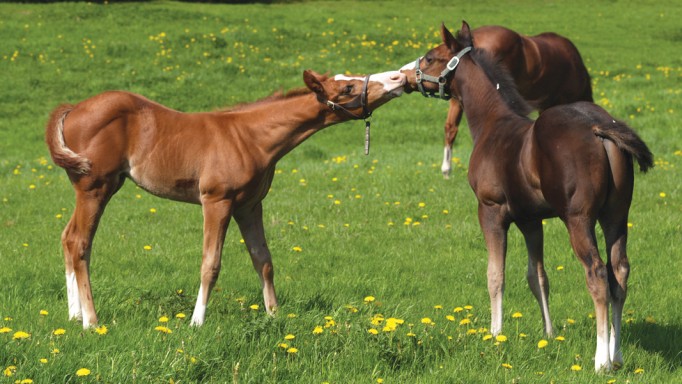Equine Proliferative Enteropathy (EPE) is caused by a bacteria called Lawsonia intracellularis which infects the cells of the foal’s intestines. An affected foal will typically have noticeable swelling (edema) under the skin, especially between the front legs, at the throatlatch, the scrotal area in colts and sometimes in the lower portions of the legs. The foal may also have fever, colic, diarrhea, weight loss, loss of appetite and a rough hair coat.
Although this disease, which usually affects foals between two and eight months of age, was only first reported in horses in 1982, it has already spread around the world, with cases reported in North America, Europe, Africa, and Australia.
Dr. Katharina Lohmann, a veterinarian (board-certified large animal internist) and associate professor at the Western College of Veterinary Medicine, University of Saskatchewan, says the disease “seems to be increasing, but it could be just that reports have become more frequent since recognition of the disease and availability of specific diagnostic tests.”
Testing & Transmission
Several diagnostic tests are now available. “None are 100 per cent, so you often need to do more than one to confirm the diagnosis,” says Lohmann. One test measures the level of protein in the foal’s blood (it will be abnormally low in a horse with EPE). An ultrasound of the horse’s abdomen may show the thickened wall of the intestines (caused by the bacteria living there). Manure can also be tested for the presence of the bacteria, and the animal’s blood can be tested for antibodies to the bacteria. Not all horses that have antibodies, though, become sick: Lohmann says researchers in Europe have found between 20 and 30 per cent of healthy foals they examined had antibodies to the bacteria without showing clinical signs of disease.
If one foal in a herd is diagnosed with EPE, should he or she be isolated from the others? Should the other foals be tested? “We don’t know exactly how this disease is transmitted from one animal to another,” says Lohmann. “There have been some outbreaks on farms, though, so it would certainly be wise to take a close look at other foals and watch for subtle signs of illness, and to discuss testing with your vet. I do think it is wise to isolate any foal with these symptoms, because there could be any number of diseases present that you wouldn’t want to spread.” Isolation may also prevent the foal that is weakened from catching other illnesses.
Treatment & Prognosis
Treatment depends in part on how sick the horse is, but the first step is a course of antibiotics that may last for about three weeks. “A foal who is quite sick may also need intravenous fluids and plasma, as well as nutritional support,” says Lohmann. The thickened intestinal lining and diarrhea that are part of this disease mean that even when the foal eats, he’s not absorbing many nutrients. Lohmann adds, “An association between intestinal parasites and EPE has been suggested, and this should be investigated and treated as well.”
EPE is rarely fatal when treated appropriately, especially if it is caught early. Lohmann notes that one researcher found there were no reports of foals who recovered spontaneously, so treatment is essential. And while the antibiotics are generally just given for three weeks, it may take several weeks longer for the foal to make a full recovery.
No studies have been done on long-term effects of the disease, but one study found that Thoroughbred foals who had suffered from EPE later sold, on average, for lower prices compared to their half-siblings from the same sire. Interestingly, though, their lifetime earnings as racehorses were about the same (Equine Disease Quarterly, Jan 2010).
In pigs, this disease is largely prevented by vaccination, and Lohmann reports that work is ongoing to develop a similar vaccine for horses. Until a vaccine becomes available, she suggests that taking steps to keep foals healthy and unstressed may be the most effective way to reduce the risk. It’s important to make sure every foal gets as much colostrum as possible at birth, and that you eliminate parasites in its environment and ensure proper nutrition. Avoid overcrowding, and consider using less-stressful approaches to weaning (see Nutrition Notes, page 26), she suggests. “And keep an eye on the foals to look for any symptoms. Early detection and treatment leads to better outcomes than if you wait until the disease has progressed and the animal is more seriously ill.”

